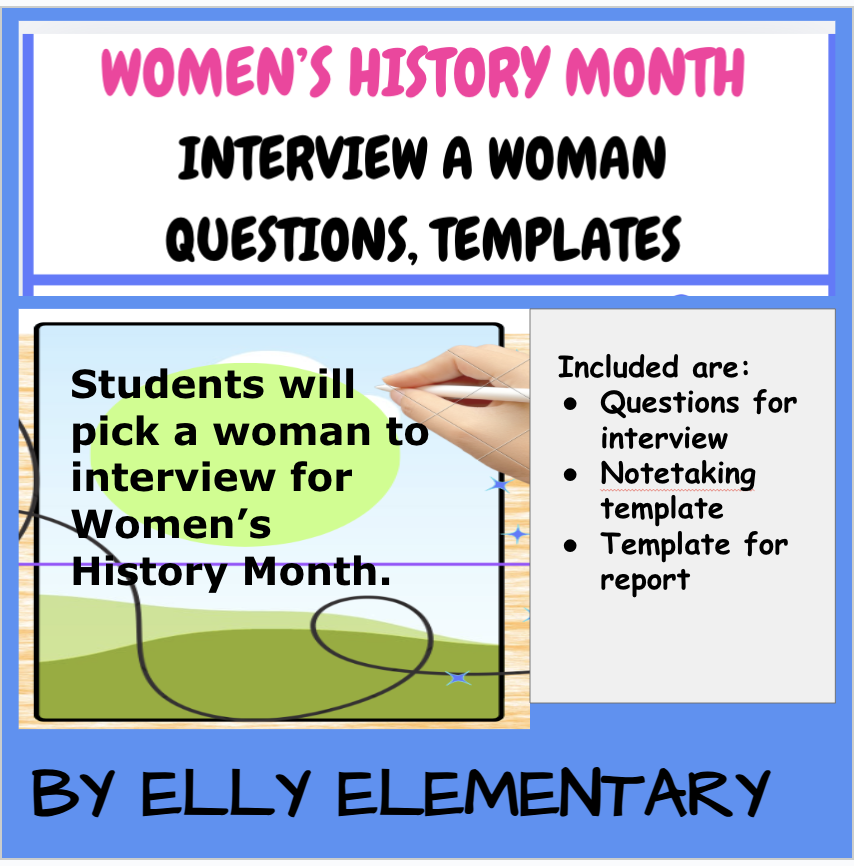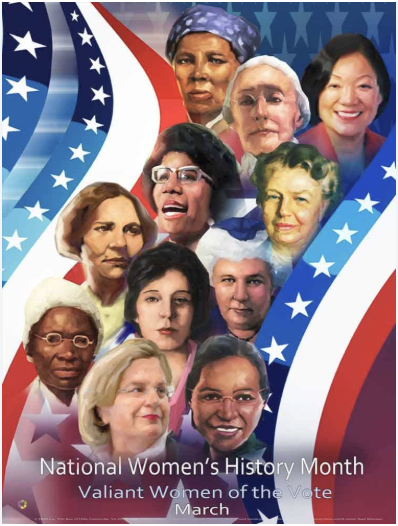Women’s History Month has a pretty interesting backstory!
It didn’t start out as a month-long celebration at all—it grew over time through grassroots efforts and official recognition.
The Origins:
- 1978: It all started in Sonoma, California, where the Education Task Force of the Sonoma County Commission on the Status of Women organized a "Women’s History Week". They chose the week of March 8 to align with International Women’s Day, which had been celebrated since the early 1900s.
- The idea was to shine a light on women’s contributions to history—something that had been largely overlooked in classrooms and textbooks at the time.
National Expansion:
- 1980: The success of the local week sparked more interest. Women's groups and historians pushed for a national celebration. That year, President Jimmy Carter issued the first presidential proclamation, declaring the week of March 8 as National Women’s History Week.
- He said::"Too often, the women were unsung and sometimes their contributions went unnoticed. But the achievements, leadership, courage, strength, and love of the women who built America were as vital as that of the men whose names we know so well."
Becoming a Month:
- Throughout the 1980s, more states and schools took up the idea.
- Then in 1987, after petitions from the National Women’s History Project (NWHP) (now known as the National Women's History Alliance), Congress passed a law designating March as Women’s History Month.
- Every president since has issued annual proclamations for Women’s History Month, celebrating the achievements and contributions of women in American history.
Why March?
- The choice of March ties back to International Women’s Day (March 8), a global celebration that originated from labor movements in North America and Europe in the early 20th century.
The Purpose:
Women’s History Month exists to correct the historical record by spotlighting women’s roles in everything from politics and science to art and social justice. It’s a time to amplify stories that were ignored or untold.
Here are some key milestones and important figures that are often highlighted during Women’s History Month. This list is by no means exhaustive, but it gives a solid sense of the movement and contributions across different areas.
🔑 Key Milestones in Women's History
- 1848 – The Seneca Falls Convention
- The first women’s rights convention in Seneca Falls, New York. Leaders like Elizabeth Cady Stanton and Lucretia Mott presented the Declaration of Sentiments, demanding equal rights, including the right to vote.
- 1920 – The 19th Amendment
- After decades of activism by suffragists such as Susan B. Anthony, Ida B. Wells, and Alice Paul, women in the U.S. finally gained the right to vote.
- 1963 – The Equal Pay Act
- Signed into law by President Kennedy, this act aimed to abolish wage disparity based on sex.
- 1972 – Title IX
- A landmark federal law prohibiting sex-based discrimination in any education program or activity receiving federal financial aid. It dramatically increased women’s participation in sports and higher education.
- 1981 – Sandra Day O’Connor Appointed to the Supreme Court
- She became the first woman to serve on the U.S. Supreme Court.
- 2016 – Hillary Clinton Becomes First Woman to Win a Major Party Nomination
- Clinton made history as the Democratic Party's nominee for U.S. president.
✨ Important Women in History
Pioneers & Activists
- Sojourner Truth
- Former enslaved woman who became an outspoken advocate for abolition and women’s rights. Famous for her "Ain’t I a Woman?" speech in 1851.
- Susan B. Anthony
- Key leader in the women’s suffrage movement. She helped secure voting rights for women in the U.S.
- Ida B. Wells
- Journalist and activist who led anti-lynching campaigns and was a co-founder of the NAACP.
Science & Innovation
- Marie Curie
- The first woman to win a Nobel Prize—and the only person to win in two different sciences (Physics and Chemistry).
- Rosalind Franklin
- Her work with X-ray diffraction images was critical to understanding the DNA double helix.
- Katherine Johnson
- NASA mathematician whose calculations were key to the success of the U.S. space missions.
Arts & Literature
- Maya Angelou
- Renowned poet, author, and activist, known for I Know Why the Caged Bird Sings.
- Frida Kahlo
- Influential Mexican painter known for her self-portraits and exploration of identity, postcolonialism, gender, and class.
Politics & Leadership
- Eleanor Roosevelt
- Former First Lady turned diplomat and activist, instrumental in drafting the Universal Declaration of Human Rights.
- Ruth Bader Ginsburg
- Supreme Court Justice and champion of gender equality and women’s rights.
- Malala Yousafzai
- Pakistani activist for girls' education and the youngest Nobel Prize laureate.
Fun Fact
The theme for Women’s History Month often changes each year. For example, in 2024, the theme was "Women Who Advocate for Equity, Diversity, and Inclusion." These themes highlight specific contributions or movements led by women.
Teaching children about Women’s History Month is such a great opportunity to inspire them, spark curiosity, and introduce big ideas about fairness, equality, and the amazing contributions women have made (and continue to make!). The key is to make it age-appropriate, engaging, and relatable.
Here are ideas, concepts, and activities you can teach children about Women's History Month:
⭐ What to Teach Kids About Women's History Month
1. What It Is and Why It Matters
- Explain simply:
- “Women’s History Month is a time when we learn about the amazing things women have done to make the world a better place!”
- Talk about fairness and equality:
- “A long time ago, women weren’t allowed to do many things, like vote or be scientists. But brave women stood up and made changes!”
2. Highlight Trailblazers & Role Models
- Share stories of inspiring women:
- Amelia Earhart (first woman to fly solo across the Atlantic)
- Rosa Parks (civil rights activist)
- Marie Curie (scientist who discovered radium)
- Malala Yousafzai (fought for girls to go to school)
- Choose people they can relate to or admire, including women in sports, the arts, and science.
3. Celebrate Everyday Heroes
- Talk about women they know—their moms, grandmas, teachers, nurses, doctors, coaches—helping them understand that women make a difference every day.
🎨 Fun and Educational Activities
1. Biography Projects
- Have them research or read about an important woman and create a poster, write a short story, or dress up as her.
2. Timeline Creation
- Make a timeline of important moments in women’s history (the right to vote, first female astronaut, etc.).
3. Storytime with Picture Books
- Read children’s books that celebrate women’s achievements.
- Some popular choices:
- “She Persisted” by Chelsea Clinton
- “Little Leaders: Bold Women in Black History” by Vashti Harrison
- “I Dissent” (about Ruth Bader Ginsburg) by Debbie Levy
4. Role-Playing & Dress-Up
- Let them pretend to be scientists, astronauts, athletes, or historical figures.
- “Today, you’re Sally Ride, the first American woman in space!”
5. Art & Craft Projects
- Make posters celebrating women who inspire them.
- Create paper badges: “Women’s History Hero” awards for people in their own lives.
💡 Simple Lessons & Takeaways
- Girls can do anything: Help them see there’s no limit to what women and girls can achieve.
- Everyone deserves equal rights: Teach the importance of fairness, respect, and standing up for what’s right.
- Celebrate differences and diversity: Recognize women from all cultures and backgrounds, making history in different ways.
🗓️ Key Moments to Explain (Simplified)
- Women couldn’t always vote → They worked hard to change the rules!
- Women weren’t allowed to be doctors or astronauts → Now they are leaders in every field!
- Women stood up for others → Like Rosa Parks, who said “No” to unfair rules

Check out my resources to help teach about Women's History:

Check out my store, Elly Elementary, for all your K-5th grade curriculum needs. I have resources for many of the March events that your class will love.
Join me on Facebook and Instagram. Let me know if you are looking for anything in particular. (Email: ellyelementary@gmail.com)



Comments ()